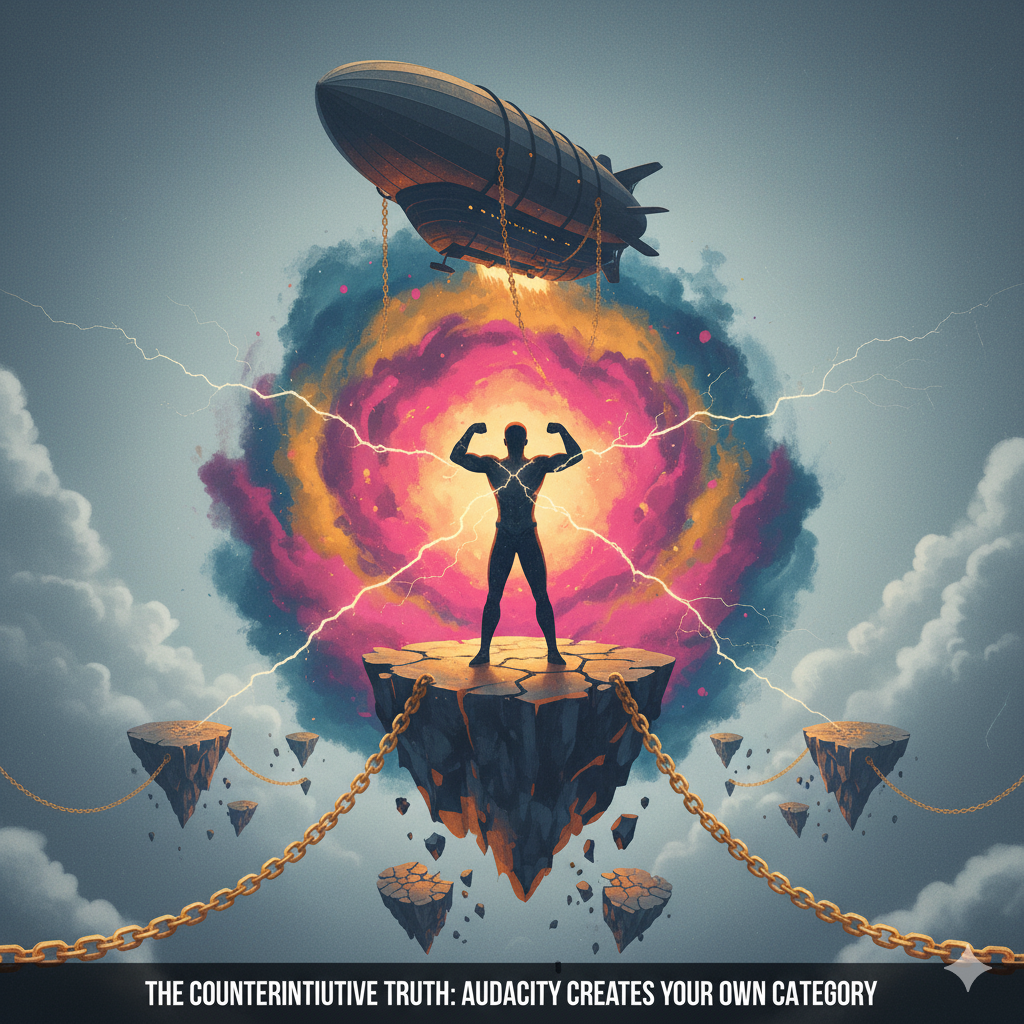Most people think competition gets fiercer as you aim higher. They’re wrong.The reality is that bold, audacious work doesn’t compete in crowded markets—it creates new ones. While everyone else fights over the same slice of pie, audacity lets you bake an entirely different dessert.
The Crowded Middle
The most competitive space in any field is the middle. Competent but unremarkable. Good enough but forgettable. This is where thousands of practitioners cluster, offering nearly identical services, products, or ideas. A decent lawyer among thousands of decent lawyers. A solid graphic designer in a sea of solid designers. A capable consultant indistinguishable from the rest.Here, you compete on price, availability, and luck. You’re a commodity.
Audacity as Anti-Competition
When you do something audacious, something genuinely bold that others consider risky or unconventional, you immediately reduce your competition. Not because you’ve beaten anyone, but because you’ve left the game entirely.Consider the architect who refuses cookie-cutter projects and only takes on experimental, boundary-pushing designs. Suddenly, they’re not competing with every other architect in town. They’re competing with the handful who operate at that level—or they’re the only option for clients seeking that kind of work.The keynote speaker who charges ten times the going rate and delivers half the content but creates transformation rather than information. The therapist who ditches the couch and takes clients hiking in nature. The programmer who only builds tools for problems no one else thinks are worth solving.These aren’t better practitioners competing in the same arena. They’re practitioners who’ve realized that audacity changes the arena itself.
Why Most People Stay Safe
If audacity reduces competition, why doesn’t everyone do it? Three reasons:
Fear of failure.
Bold moves can fail spectacularly. Playing it safe means you might not win, but you probably won’t lose dramatically either. Except you do lose—slowly, invisibly, in opportunities never taken and potential never realized.
The approval trap.
Audacity often means doing things others consider foolish. The consultant who turns away 90% of clients. The artist who destroys commercially successful work to pursue a risky new direction. Most people need permission and validation more than they need differentiation.
Skill as security blanket.
Many practitioners believe that getting better at their craft—more credentials, more technique, more competence—will set them apart. It won’t. Competence is the entry fee. Audacity is what makes you unforgettable.
What Audacity Actually Looks Like
Being audacious doesn’t mean being reckless or contrarian for its own sake. It means:Having a point of view so strong that some people will disagree with you. If everyone nods along, you’re still in the middle.Saying no to work that doesn’t align with your vision, even when you need the money. Each compromise pulls you back toward the crowded center.
Doing the thing that makes you slightly uncomfortable every time you mention it. That discomfort is often a signal that you’re onto something differentiated.Charging what your transformation is worth, not what your time costs. This alone eliminates 90% of your “competition.”
The Math of Differentiation
Think about it mathematically. If you’re a competent copywriter, you’re competing with tens of thousands of people. If you’re a competent copywriter who only works with sustainable fashion brands and charges premium rates, you’re competing with dozens. If you’re that person who also has a provocative methodology and a waiting list, you’re competing with yourself.
Each bold choice narrows the field. Not because others can’t do what you do, but because they won’t. They’ll stay safe. They’ll keep their options open. They’ll try to appeal to everyone.And they’ll stay stuck in the traffic jam of the middle while you drive in your own lane.
The Compounding Effect
Here’s what happens when you make audacious moves consistently:You attract different clients—ones who seek out bold practitioners because they want bold outcomes. These clients are less price-sensitive, more committed, and become better case studies.You build a reputation not for being good, but for being distinct. Distinct is memorable. Good is not.Your work improves faster because you’re pushing boundaries rather than perfecting the standard approach. Innovation happens at the edges, not in the center.You enjoy your work more because you’re doing it your way. This isn’t a small thing—it’s the difference between a career and a calling.
Start Where You Are
You don’t need to blow up your entire practice tomorrow. Audacity can start small:
Take on one project that scares you. Pitch the idea others said wouldn’t work. Charge double your normal rate to one client and deliver something extraordinary. Publish the opinion you’ve been holding back.The first bold move feels like stepping off a cliff. The second feels like a calculated risk. By the tenth, it feels like how you work.
And somewhere along the way, you’ll look around and realize you’re no longer competing. You’re creating. And creation, by definition, has no competition.The crowded middle will always be there, packed with talented people fighting for scraps. But the edges—the audacious, bold, slightly crazy edges—are wide open and waiting.The question isn’t whether you’re good enough to be audacious. It’s whether you’re brave enough to stop competing.


